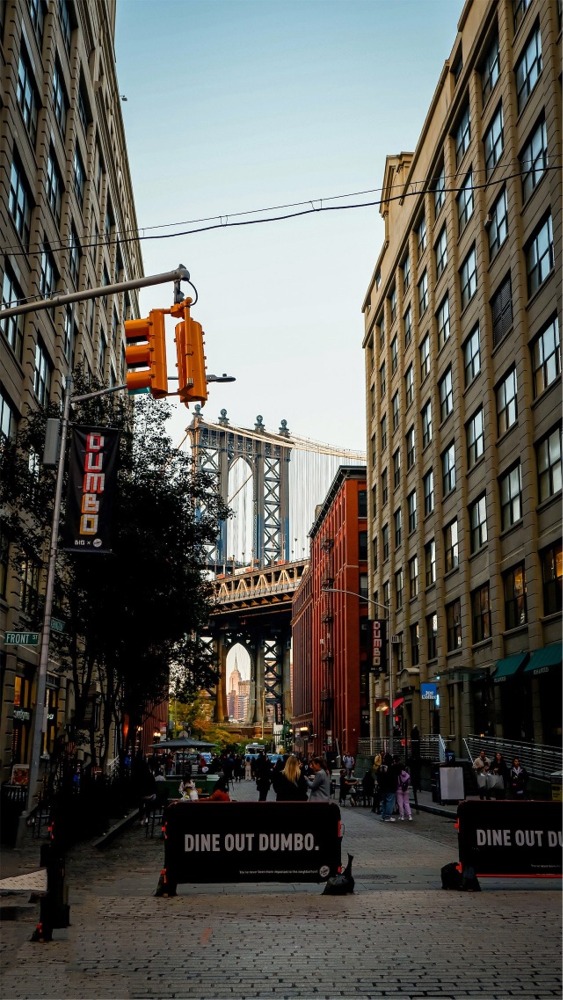Dine Out Dumbo
Manhattan Bridge Pier
Home > New York State Photographs > New York > Dine Out Dumbo - Manhattan Bridge Pier

The South Pier of the Manhattan Bridge framed the majestic Empire State Building, creating a stunning visual. At the forefront of the scene were the 'Dine Out Dumbo' signs, a vibrant reminder of the spirit of Brooklyn. Below the bridge, Washington Street was alive with people strolling across the cobbled pavement, between Water and Front Streets. It was late in the afternoon, and the sun was slowly starting to descend, casting the streets in an enchanting shadow. Yet the rays of the sun still sparkled off the steel of the Manhattan bridge, creating a dramatic contrast.
The air around Washington Street was filled with a pleasant hum, the conversations of the people enjoying the late afternoon ambience. The scene was at its most captivating in this light, the perfect postcard of a Brooklyn day, and the perfect backdrop to the conversations of the city's inhabitants. As the sun set, the atmosphere only became more vibrant, further highlighting the beauty of this iconic image of Brooklyn.
Manhattan Bridge
The Manhattan Bridge is a historic and iconic suspension bridge that spans the Lower East River, connecting the boroughs of Manhattan and Brooklyn in New York City. It is one of the city's major river crossings and an important transportation artery. Here's an overview of the Manhattan Bridge:
History and Construction
- The Manhattan Bridge was designed by the suspension bridge engineer Leon Moisseiff and opened to traffic on December 31, 1909.
- It was the third bridge to be constructed across the Lower East River, following the Brooklyn Bridge and the Williamsburg Bridge.
- The bridge's design features a main suspension span and two side spans, flanked by viaducts on either end. The central spans are supported by large towers made of steel.
Architecture and Features
- The bridge's distinctive appearance includes a "web" of vertical cables descending from the main suspension cables, giving it a classical and recognizable look.
- The Manhattan Bridge has a higher profile compared to the nearby Brooklyn Bridge, and its tracks are positioned on the outside of the bridge structure, making it a key element in the city's transit network.
Transportation Significance
- The Manhattan Bridge is a vital link for both vehicular and pedestrian traffic between Manhattan and Brooklyn.
- It carries 7 vehicle lanes for cars and trucks, as well as four tracks for subway trains. The New York City Subway's B, D N and Q lines use the bridge to cross the East River.
- The bridge has also accommodated streetcars in the past and currently has a pedestrian walkway and a bike path, making it accessible to pedestrians and cyclists.
Cultural and Iconic Importance
- The Manhattan Bridge's unique design and its prominent position in the city's skyline have made it a symbol of New York City.
- It has been featured in numerous films, television shows, photographs, and artistic works, contributing to its cultural significance.
- The bridge offers impressive views of the Manhattan skyline and the East River, making it a popular spot for tourists and photographers.
Renovations and Upgrades
- Over the years, the Manhattan Bridge has undergone various renovation and restoration projects to ensure its safety and maintain its historical integrity.
- Upgrades have included replacing sections of the bridge deck, repairing cables, and improving subway tracks and infrastructure.
Challenges and Resilience
- Like many older infrastructure elements in New York City, the Manhattan Bridge has faced challenges related to wear and tear, increasing traffic demands, and the need for modernization.
- It has endured the effects of weather, aging, and even a fire that damaged a portion of the bridge's upper structure in the early 20th century.
In summary, the Manhattan Bridge is a significant and iconic part of New York City's transportation network and cultural landscape. Its unique design, historical importance, and role in connecting Manhattan and Brooklyn make it a cherished landmark in the city.


